You can make a reliable and relatively inexpensive fence for the site with the help of a combined fence - poles are made of bricks, and filling (spans) and any lightweight material - wood, professional leaf, forged fence. The view is solid, and the cost is much less than on the "purely" brick fence. And the laying of the poles is not the most difficult thing, but favorable. Masters asked for another two years ago from 2000 rubles per pillar, and today prices have risen more than twice. Fold brick columns to fence with your own hands and without the skills of the mason. It is important to comply with technology and everything will work out.
Foundation for a fence with brick columns
Selecting the type of foundation under brick poles depends on what material will be filling as well as from the type of soil. If the span of the fence is from lightweight material (professional flooring, wood), you can make a pile foundation for each pillar. The depth to which the pile should be scored / twisted, depends on the type of soil and height of groundwater. If the soils are prone to winter beagle (clay or loam) with highly located underground waters, you need to dig up 15-20 cm below the depth of the soil. On well-drainaged soils (sand and sandy), it is enough to jump at 80 cm.
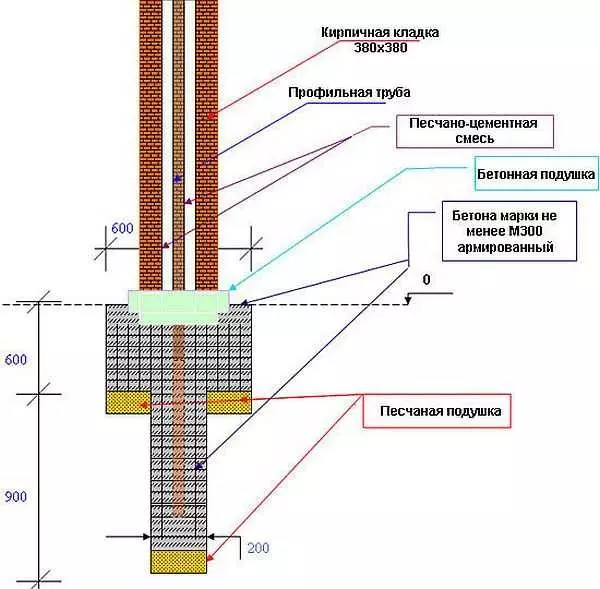
Pile foundation for a brick post for a fence with a slight filling
The pile foundation under the brick pillar is done according to the standard technology:
- Bryat the fossa of the desired depth (diameter 25-35 cm);
- on the bottom fall asleep bucket-two rubble;
- compacted;
- They put the pipe around which will subsequently lead a pillage (on bunched soils to the bundled part, several segments of metal rods, ribbons, corners are more sustainable);
- The pipe is set strictly vertically, fixed;
- For bunching soils, if metal pieces did not weld to the pipe, you can stick a few reinforcement rods in the hole, for very complex soils you can connect the frame;
- A high brand concrete is poured - M300 or higher (about the brand and composition read here).
The length of the pipes folds out of two values: from the part that is immunted into the concrete and the one that will hang on top. Moreover, the upper part of the pipe is not at all necessary in this case should be up to the top of the pillar. It can be at 40-50 cm shorter. Exception - pillars to which the gate will be hung and / or wicket. Here the internal reinforcement must be almost up to the top.
If the fence is scheduled to be completely brick or in the region large wind loads, most likely, you will need to make a full-fledged belt foundation. Another option is the piles bound by a fine breeding ribbon.
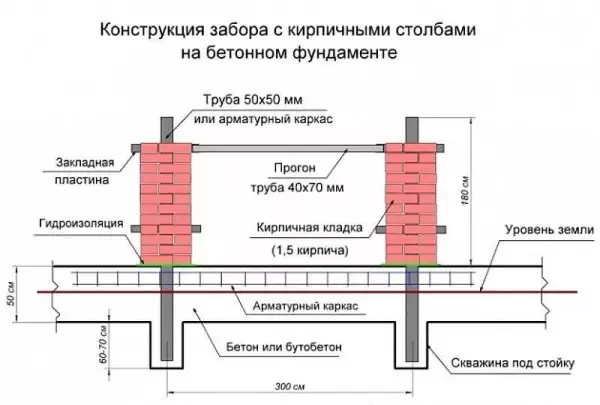
Design of fence with brick columns on a monolithic reinforced concrete foundation
Read more about the types of foundations for all sorts of fences, read in the article "The foundation for the fence: how not to bury extra money".
Article on the topic: How to put a tipped floor board
Solution and bricks for columns
The solution is made cement-sand with a proportion of 1: 5 (or 1: 6). The sand is better to take the shallow fraction, the high brand cement is not lower than M400. For plasticity, you can add a little liquid soap for hands or detergent for dishes (20-30 gr. On the standard kneading bucket).
It is important when making a solution to obtain the necessary fluidity. It should not be dry, but it is inconvenient to work with liquid, therefore water is added gradually, following the consistency of the solution. The desired condition can be monitored as follows: spread some surface for some surface, to put the cross on it on it. Then take the marked plot on the celma and follow the cross: it should not "swim".
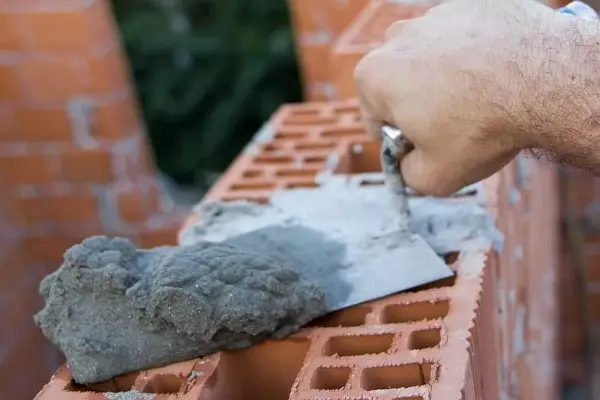
Optimal consistency solution for masonry brick columns
If you wish, you can get a black solution: add soot to it. It is sold in building stores bags. Adjust a small portion of soot and get decorative seams without painting.
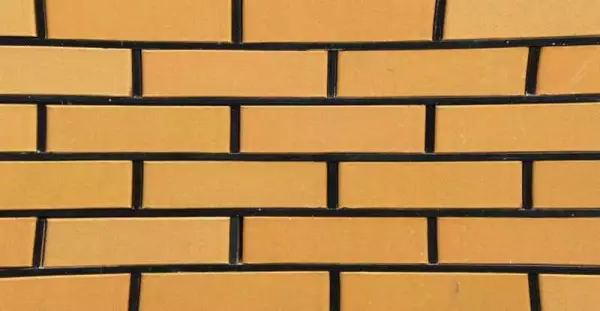
Black Solution adds decorativeness
Brick for pillars use any, only pay attention to the number of cycles of frost defrost (the more, the better) and geometry. Ideally, the deviations in size should not be more than a pair of millimeters. Then it will be easy to work. If the party came across a different-caliber - carefully sort into size so that in one post bricks had a minimum discrepancy.
Laying of intake pillars: technology
In most cases, the fence poles are made in 1.5 or 2 bricks, the cross section 380 * 380 mm and 510 * 510 mm, respectively, the height is up to 3 meters.
The masonry leads with a dressing (displacement) - seam of the lower row overlapped by the "body" of a brick lying on top. Standard seam - 8-10 mm. The layout scheme of columns on one and a half and two bricks in the photo below.
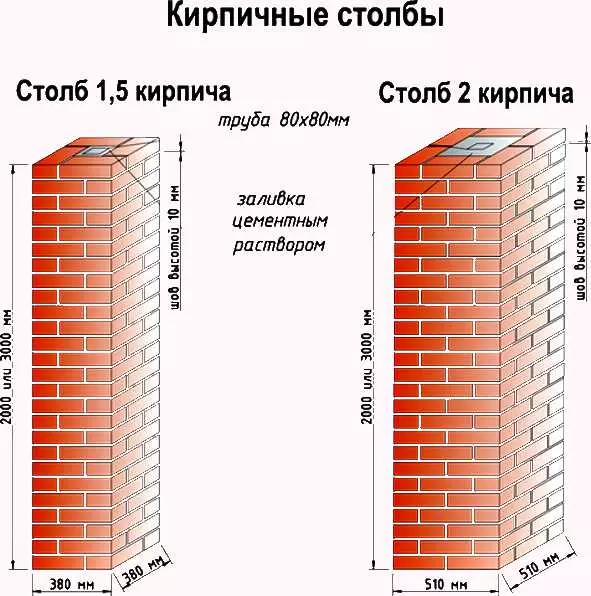
Brick poles in 1.5 and 2 bricks
Pillars masonry: work order
On the finished foundation, the cut-off waterproofing is spread. It can be a rubberoid in two layers, but it is better to hydroize on bitumen mastic. This layer is necessary for the brick does not "pull" moisture from the soil. If a wet brick freezes, he quickly begins to crack and crumble. Therefore, waterproofing is necessary. Rolled waterproofing can be replaced - twice the foundation of the bituminous mastic twice, and in areas with high humidity it is better to make double waterproofing - to lift with mastic, and then the "hydroisol" can also be used.
In size, a solution of a layer is applied to the waterproofing of a layer of a little more than 1 cm. On it, according to the scheme, bricks are stacked. They are aligned in vertical and horizontal planes, tapping with a special rubber hammer. The wizards can use the Kelle handle, but in this case, the residues of the solution can fly from the plane of the Kelma, stacking hands and brick, and it rubs away from cement badly.
Ceramic bricks very quickly absorbs moisture, therefore a little tasty, it will be difficult for you to "plant" him in place. In order for the solution longer to maintain plasticity, brick before laying for a few seconds dip in water. The same maneuver makes it easier to wipe the solution from the surface (it is removed immediately, a dry cloth).
Article on the topic: Fastening clothes rope on the balcony
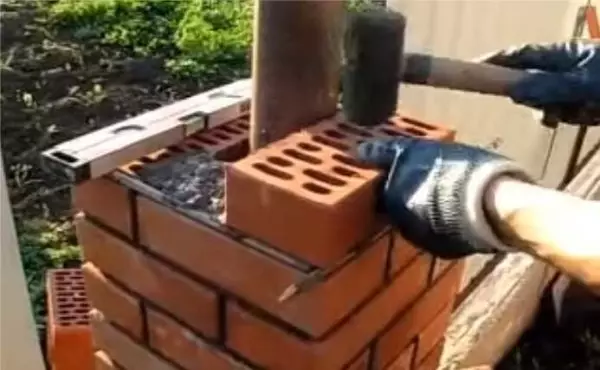
Wear a hammer
The second row is also put on the bricks, the solution is spread, bricks are set on it, but already with the dressing - it turns out that the seam is blocked. Align again. Then take a roulette and check the size of the laid rows. Even a small displacement of 1-2 mm is eliminated. Touch the front of the brick (called the "stack"), shifting the bricks closer. Then, if the side faces did not obsidese, fill vertical seams. All subsequent ranks are flattened.
If there is emptiness between the inner pipe of reinforcement and brick masonry, it is filled. If the distance is small, you can use a masonry solution if the emptiness is significant, to save space you can float with rubble, tamper, then shed liquid cement-sandy solution.
Laying under rod
The laying of the columns described above has long been tested, but beginners, with independent manufacture, heavily withstand smooth seam. Another problem - the solution gets out of the seam, a stacking surface. It turns out not very beautiful. To facilitate work, we invented masonry under the rod. Take a square metal bar with a side of 8-10 mm, cut it out not pieces, 10-15 cm long post sizes.
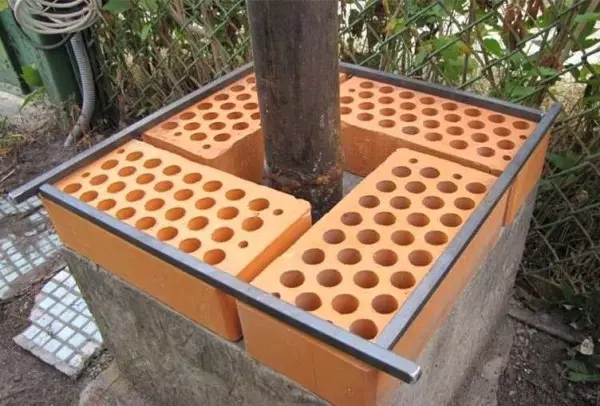
Laying bar
Setting the first row, a bar is laying on the edge of the brick. Fill the platform with a slight margin, and the layer is closer to the tube more. Then, leading the rod by the rod, remove the surplus, cleaning the rod from the solution. But at the same time the slope of the solution is preserved. They put a brick, align it in terms of level. At the same time, it does not give him a rod, and the position of the other end control the level.
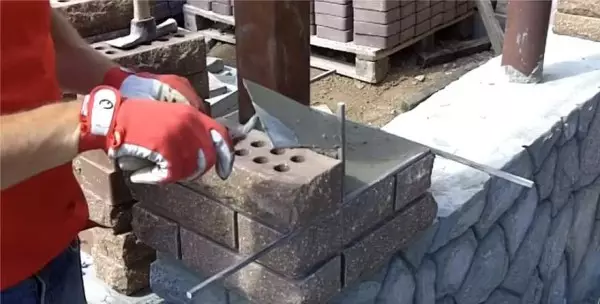
Under the rods we apply a solution on the side face
Then they take a short rod segment about 10 cm (for vertical seam), they put it along the twist, the solution is applied to the side of the stapled brick, also removing the surplus along the rod. It is put and lines the second brick. After the level is exhibited, the seam is pressed on top of the cylma, and the vertical bar is removed.
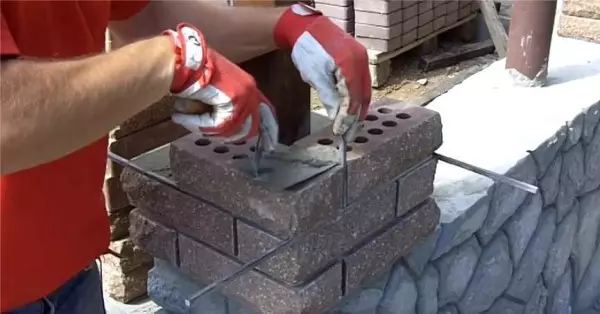
Take out the rod holding the seam
So all the bricks are laid out. Then the rods are removed, proceed to the next row. This laying technology of brick pillars allows you to control the seams and make them neat. So add a pillar with their own hands, even a novice amateur mason can. It is important only in the process to control the parameters of each row (so that the pillar in the cross section is one size).
Video lessons
A more complex brick column variant - screwed screw
Features of working with ceramic brick
Possible problems and their solution
The main problems that may arise when the pillars are laying do it yourself - this is a change in the size and "twisting". Both defects arise due to insufficient control.
When laying columns with their own hands, often the upper rows become much wider than the lower. This happens gradually, a millimeter is added or even less, but in almost every row. As a result, at an altitude of 2 m column width of 400 mm and even more. It instead instead of 380 mm. Correction of this error - control of the size of each row.
Control the sizes of the post only by the construction level is not enough. Mainly, a household tool (yellow) is used, and it has a sufficiently large error and if the level has a length of 60-80 cm, you simply will simply see the level of vertical deviations. Therefore, additionally use roulette - swearing each row. To reduce the time that goes to control, you can make a template template (for example, from smooth planks) to check the presence of deviations.
Article on the topic: Connecting a washing machine to water supply and sewage with your own hands
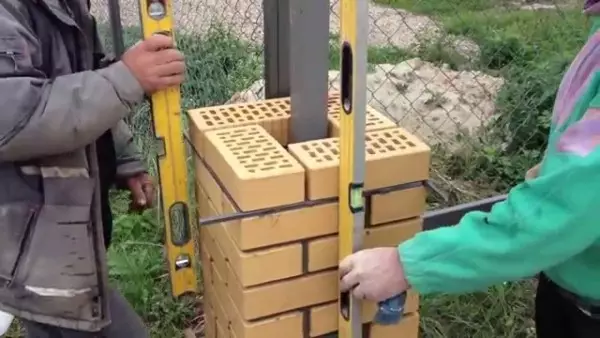
The laying of pillars for the fence is carried out around the metal reinforcing pipe, the verticality is checked after laying each row
Self-laying of columns Without the experience of such work can lead to another error: the side of the pillar can be shifted, the pillar, as it should be twisted around its axis. This disadvantage is much more unpleasant: try to attach spans to such columns. There will be many problems. Therefore, when laying each row, it is necessary to strictly ensure that the angles are located strictly one over the other.
You can easily facilitate the task using two corners screwed to the opposite corners. They are temporarily attached to the lower rows (bolts or screws in the seam) and then use as a landmark, putting bricks strictly into the corner.
Mortgage elements and gate mount
When laying brick columns, we need to think about how you will be attached to them. So that there was an opportunity to fix horizontal guides to fill the fence to the pipes located in the middle of the column, pre-weld the mortgages. It can be corners, studs, "ears" for fastening wooden planks, etc. They weld them at one height so that the attached crossings were strictly horizontal.
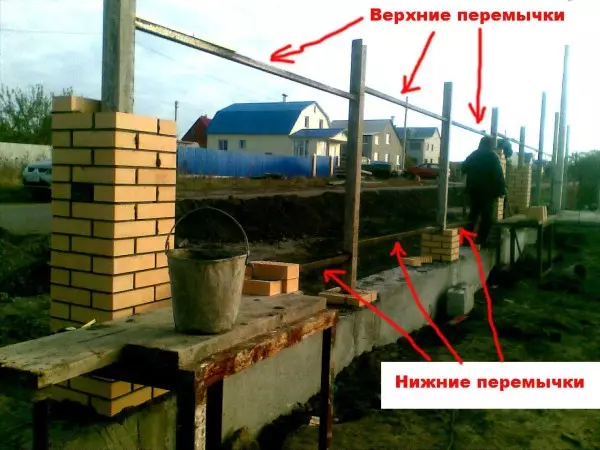
One option is suitable for fastening professional flooring, stakenist
Mortgage options can be different. Someone makes out of the corner, someone has enough studs. It all depends on the type of filling of the fence (from which the spans) or the mass of the goal sash will be made.
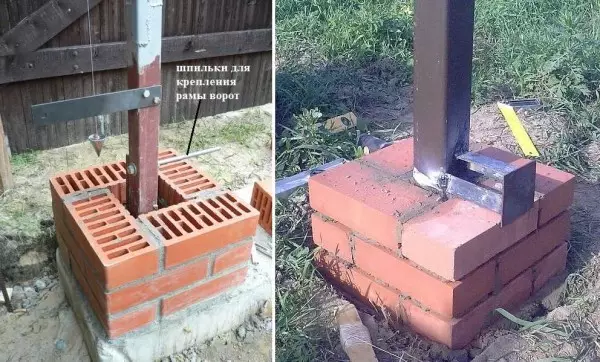
Mortgage options in brick columns
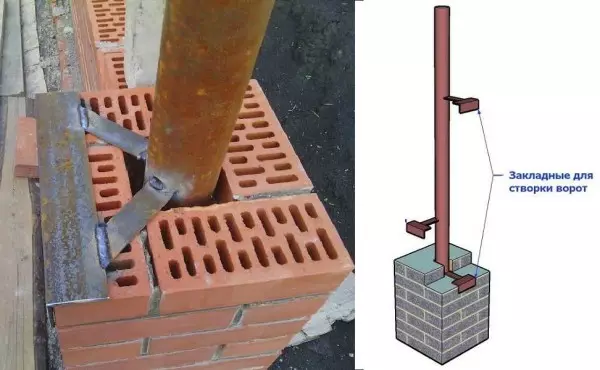
Under different weight need different power elements
Under the gate or gate requires at least three metal parts with a metal thickness of at least 3 mm (better than 4 mm or even more).
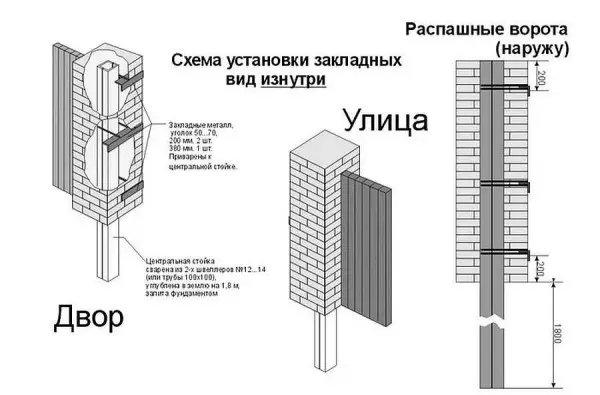
Example of location of mortgages for swing gates
The device and installation of the rollback gate are described here. About how to automate the swollen gate, read here.
Making a cap on a brick pillar
To protect the brick from moisture, the top of the pillar is closed with a cap. They are sold in large quantities, there are metal, concrete or composite. If desired, the cap on the pole from roofing can be made with their own hands. Below is the scheme. You can only substitute the size, and then bend on the sheetogib on the outlined lines. Basin the product with special rivets, but you can also use self-tapping screws. Only it will be necessary to pre-drill holes, misconfigure them with anti-stroke, then paint.
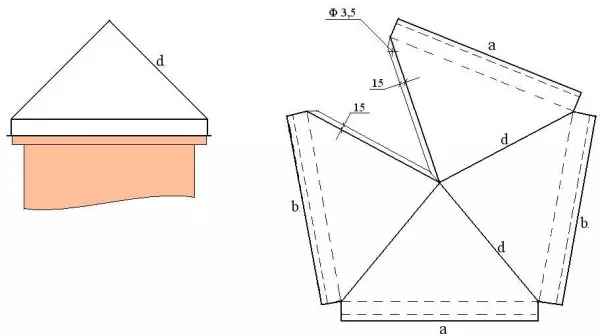
Cap drawing on a brick pillar
Photo ideas of fences with brick columns
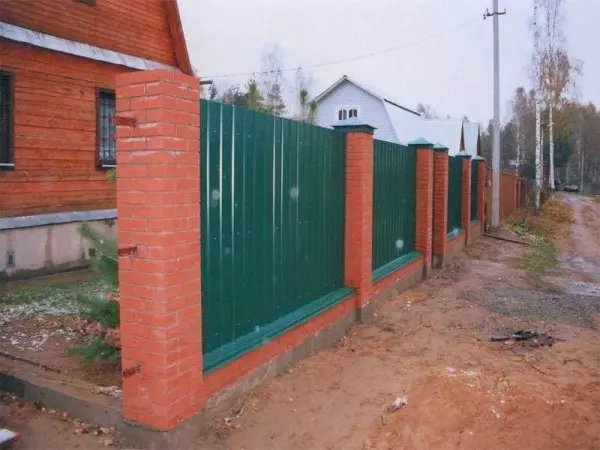
The most popular option is a fence of a professional flooring with brick columns
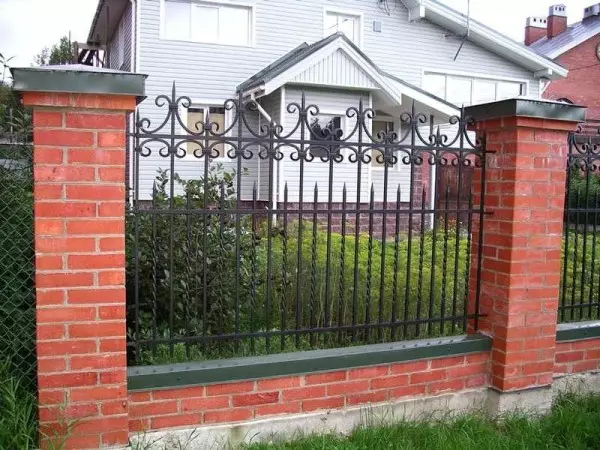
Forging always looks good
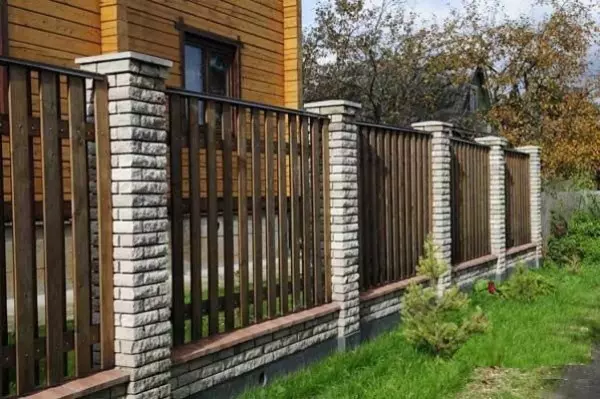
Ripped stone and stakenik - Combined fence
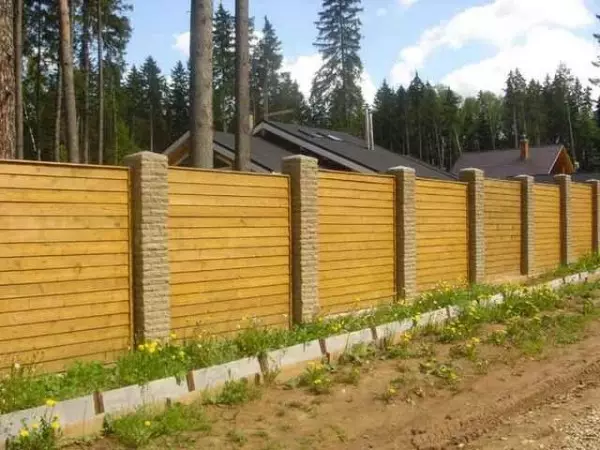
Wood filling can be solid
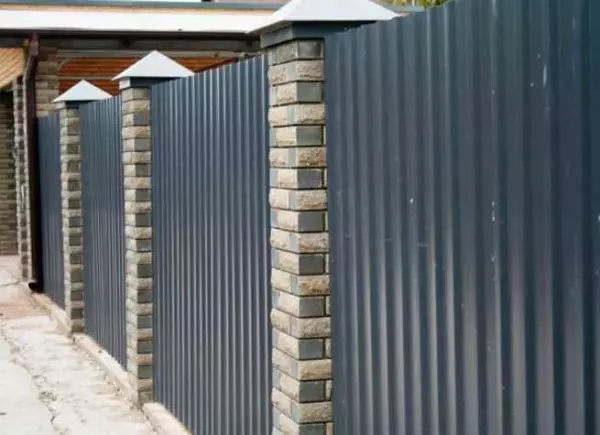
Decorative brick poles decorate the fence
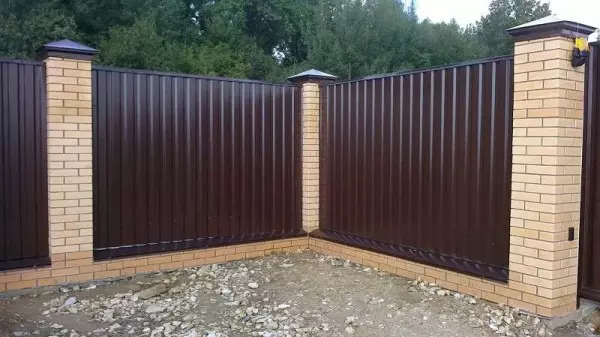
The most popular burgundy color on the fence
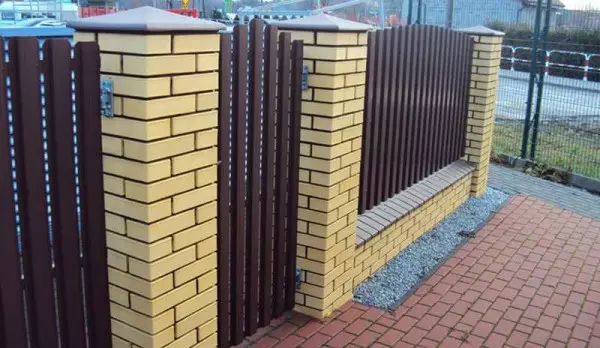
In combination with the European passman

Twisted poles for advanced masonry
